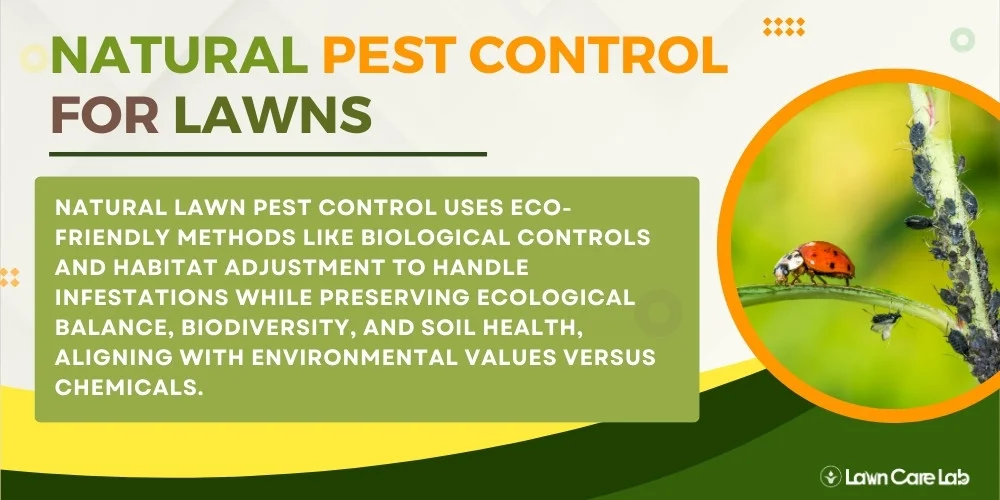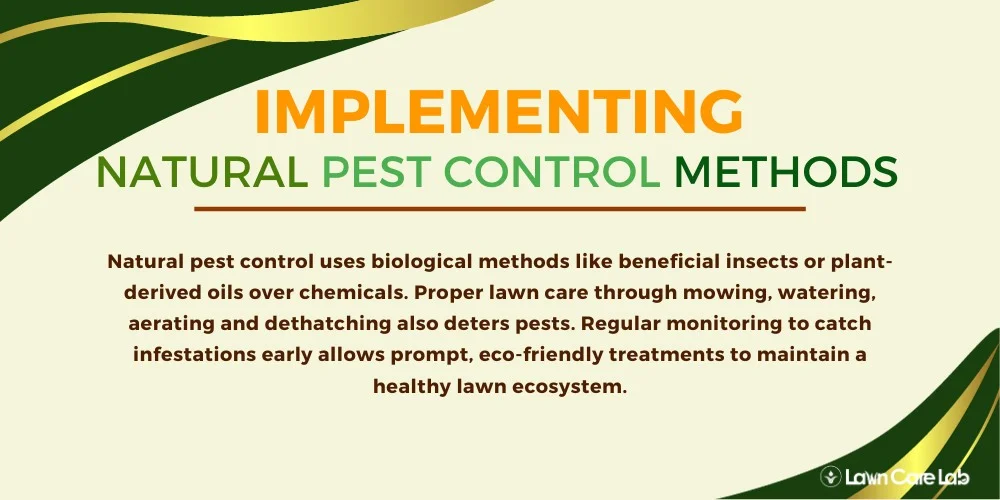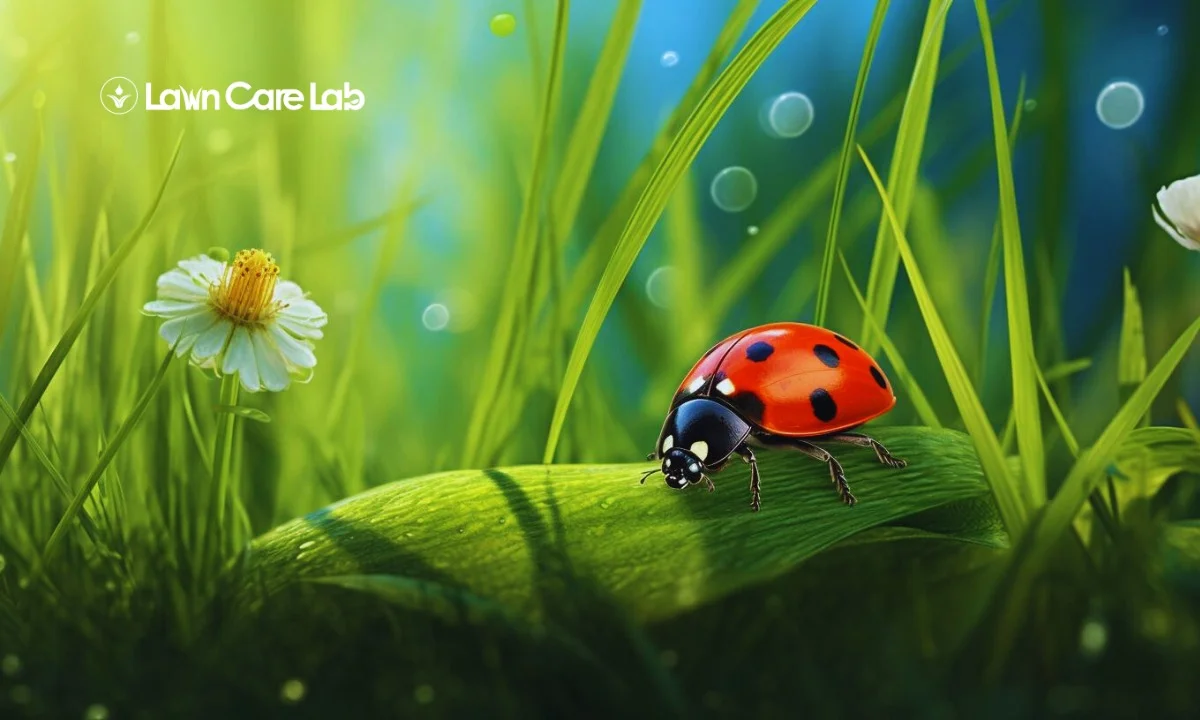Are you frustrated with pests destroying your beautiful lawn? Before thinking about using harmful chemicals, there’s something you should know. Natural pest control methods can work just as well and are much safer for you, your loved ones, and the planet.
Let’s discuss how you can spot common lawn pests and use environmentally friendly measures to keep them under control. Eager to start a more sustainable journey? Let’s get you on the path to natural pest control.
Table of Contents
Natural Pest Control for Lawns

Natural pest control for lawns is about preserving the environment while maintaining a beautiful front yard.
You can handle pests without harming the planet with eco-friendly alternatives like biological control and habitat manipulation. This green approach to lawn care isn’t only effective but also aligns with the current global focus on environmental responsibility.
Understanding the Importance of Organic Pest Management
Organic pest management sustains lawn health by controlling pest numbers, preserving biodiversity, and maintaining ecological balance.
Here’s how organic pest control works:
- Sustains ecological balance: It reduces the use of harmful chemical pesticides and promotes beneficial organisms..
- Boosts lawn health: It encourages the soil nutrient cycle and wards off harmful pests, preventing lawn damage.
By adopting these methods, you do more than just protect your lawn. You’re also contributing to a safer environment.
As the famous environmentalist Rachel Carson once said, ‘In nature, nothing exists alone.’ This quote beautifully encapsulates the essence of organic pest management – promoting balance and harmony with nature.
Identifying Common Lawn Pests

To maintain a healthy lawn, it’s important to identify harmful pests, fungi, and animal intruders. Knowing your enemy allows you to choose suitable organic pest control strategies. Learn about potential threats and establish a defense strategy using eco-friendly solutions to keep them at bay.
Types of Pests that Threaten Your Lawn
Rodents, insects, grubs, weeds, and fungi can seriously threaten lawns. This article will discuss the impact of pests on lawns and ways to identify warning signs.
Staying home more means we focus on outdoor spaces. A healthy lawn adds value and looks good. But pests like insects, fungi, and rodents can damage it.
Rodents like moles and voles can cause extensive damage to your lawn by burrowing into it, in addition to insects, grubs, weeds, and fungi.
Identifying signs of pests is crucial to safeguarding your lawn. Discolored patches may indicate insect or fungus problems, while small mounds of dirt or tunnels are signs of rodents.
Understanding these threats is crucial for maintaining a healthy, thriving lawn. As the old saying goes, ‘Forewarned is forearmed.’
Insects and Grubs
Bugs and grubs in lawn care can cause irreversible damage by feeding on the roots of the grass. Identifying these pests is crucial for maintaining a healthy lawn.
Take, for instance:
- Beetles: These critters can lead to the formation of unsightly yellow patches.
- Ants: Surprisingly, ants can be lethal to your grass.
Identify lawn insects to defeat them easily. Stay vigilant and proactive in lawn care to keep it bug-free.
Weeds and Fungi
Weeds and fungi can harm your lawn as much as insects. Weeds can deprive grass of vital nutrients and hydration, leading to decay. Fungi can lead to diseases and unsightly brown patches.
Having understood these risks, our discussion proceeds to another potential issue — the damage caused by rodents and other animals.
Rodents and Other Animals
In the world of lawn care, the presence of rodents and other creatures can significantly impact your verdant grass.
Let’s consider a few culprits:
- Moles: These creatures dig tunnels in your lawn, leaving behind mounds of soil that can ruin your landscape.
- Voles: These are somewhat similar to moles and can wreak havoc on your lawn.
- Rabbits and birds: They can consume your grass and its seeds, leading to damage.
Manage animal intrusions to preserve lawn appearance and health. Proactive prevention is vital for a well-maintained lawn and ecosystem.
Implementing Natural Pest Control Methods

To practice eco-friendly pest control, you must first identify the pests in your garden. Then, use natural methods like biological control, which involves using beneficial insects or birds, or the botanical approach, which uses plant-derived substances.
These methods not only eliminate pests but also promote a healthier garden ecosystem.
Biological Control Techniques
Some bugs are good for your garden. You can use biological control to turn them into allies. You can create a natural defense by attracting beneficial bugs that eat harmful pests.
Ladybugs and lacewings eat aphids and other pests. Encouraging these insects can reduce harmful pests and improve your garden’s health.
Using Beneficial Insects
Use beneficial insects like ladybugs, lacewings, and parasitic wasps to control lawn pests naturally.
- Ladybugs: They’re proficient predators of aphids, mites, and mealybugs.
- Lacewings and parasitic wasps: They specifically hunt down destructive insects like caterpillars and beetle larvae.
Ladybugs are eco-friendly pest control agents that can keep your lawn healthy. They are tiny warriors fighting for your lawn’s health.
Attracting Pest Predators
Use nature to fight garden pests. Invite predator species like birds, frogs, and bats to manage pests instead of harmful chemicals.
| Wildlife | Advantage |
|---|---|
| Birds | Feed on damaging insects |
| Frogs | Regulate insect population |
| Bats | Prey on nocturnal pests |
Invite these creatures to your garden for natural pest control and a thriving lawn. As David Attenborough said, nature is a source of excitement, beauty, and interest. Use it to maintain a healthy, pest-free garden.
Botanical Pest Control Techniques
Botanical methods can be used for pest control by incorporating pest-repelling plants in your garden or lawn. Marigolds and citronella plants are great examples known for their pest-deterring properties.
Essential oils extracted from plants are effective in managing pests. Citronella, lemongrass, and peppermint oil are known to repel pests.
Planting Pest-Repelling Plants
Incorporating certain plants into your garden provides a smart, nature-friendly way to protect against bothersome pests. Some of these include marigolds, lavender, and rosemary.
- Marigolds are known to repel aphids and mosquitoes. Strategically placing them near doors or outdoor seating areas can help reduce these pests.
- Lavender, apart from being delightfully fragrant, is a deterrent to moths, fleas, and flies. It’s ideal as a border plant, adding beauty while serving a functional role.
- Rosemary, a popular herb, has the additional benefit of discouraging various insects. It’s a versatile plant that does well in containers.
Using Essential Oils
Essential oils from plants like neem, eucalyptus, and citronella can serve as organic insecticides for eco-friendly pest control.
Let’s take a closer look at these oils:
| Essential Oil | Pest Targeted | Safety Note |
|---|---|---|
| Neem | Aphids, Mites | Harmless to pets |
| Eucalyptus | Mosquitoes, Flies | Avoid direct contact with eyes |
| Citronella | Mosquitoes, Ticks | Ideal for outdoor use |
Proper Lawn Care Practices
For a healthy lawn, watering and mowing are not enough. Soil aeration and dethatching are essential for robust growth and pest control. Check regularly for issues and use natural pest deterrents. A well-maintained lawn is beautiful, safe, and a mini ecosystem.
Regular Mowing and Watering
To keep your lawn looking fresh and healthy, regularly mow and water it. This also helps keep pests at bay.
- Frequent mowing: Preserves ideal grass length. Discourages pests
- Frequent watering: Provides necessary hydration and Boosts grass vitality
As a wise gardener once said, ‘A well-cared lawn is a pest’s worst nightmare.’ So, why not give your lawn the care it deserves?
Soil Aeration and Dethatching
Soil aeration and dethatching are both crucial for a healthy lawn. Aeration promotes root growth by allowing air, water, and nutrients to reach them, making the lawn resilient. Dethatching removes dead grass and roots, reducing the places where pests can hide or reproduce.
| Practice | Benefit | Result |
|---|---|---|
| Soil Aeration | Enhances the flow of air, water, and nutrients | Encourages root growth |
| Dethatching | Eliminates dead grass and roots | Decreases pest hiding places |
Implementing these practices can essentially transform your lawn into a safer and healthier space.
Monitoring and Regular Check-ups
Regularly check your lawn for pests to maintain a healthy, vibrant lawn using natural pest control techniques and contribute to a safer environment.
When conducting your lawn check-ups, here are some steps to keep in mind:
- Scrutinize your lawn meticulously: Be on the lookout for patches of brown, which may indicate the presence of pests like grubs, beetles, and other insects.
- Assess the well-being of your plants: Wilted or yellow leaves may indicate pests. Record sudden changes in plant growth.
Detecting pests at an early stage enables you to apply control measures promptly and efficiently, helping your lawn remain lush and vibrant.
Evaluating the Effectiveness of Natural Pest Control
Assessing the impact of natural pest control requires careful observation.
It’s necessary to keep an eye on pest population changes to evaluate your approach’s effectiveness.
But it’s not just about the number of pests. You also need to assess the general health and growth of your lawn.
Studies indicate that a flourishing, green lawn often signifies effective pest control.
Observing Changes in the Pest Population
When using natural methods to control pests, it’s important to stay vigilant about any pest number changes to assess your methods’ effectiveness. Doing so gives you a precise idea of how well your measures are working.
Here’s how you can do it:
- Initial Pest Tally: Start by assessing the pest count in your garden before implementing any control measures. Watch for signs of pest presence, such as plant damage or molehills.
- Regular check-ins: It is crucial to periodically monitor pest activity and compare it to the initial count.
A methodical approach assures the well-being of your garden and allows for modifications. As a seasoned gardener said, “Monitoring pests is as crucial as controlling them. It’s a game of patience and strategy.”
Assessing Lawn Health and Growth
For effective natural pest control, check your lawn’s condition. A uniform color, lushness, and resilience indicate a thriving lawn. Wilting or dying grass may mean ineffective pest control. Check soil nutrients and pH levels for imbalances. A healthy lawn can prevent pests naturally. Prioritize safety with non-toxic methods.
Embrace a Greener Future with Natural Pest Control
Natural pest control methods benefit your lawn and the environment.
Let’s discuss the two main components:
- Health and Safety
- Avoiding toxic chemicals ensures your loved ones and pets are safe.
- Organic procedures improve soil richness, fostering the growth of resilient, lush grass.
- Impact on the Environment
- Employing organic pest control minimizes chemical leakage, safeguarding our water bodies.
- It supports biodiversity, preserving a harmonious ecosystem in your garden.
So, adopting nature-based pest control methods isn’t a short-term strategy. It’s a pledge towards a cleaner, more sustainable future. It’s time to make that commitment.
As the saying goes, ‘A journey of a thousand miles begins with a single step.’ In our case, that step is choosing nature-based pest control. Let’s take that step together for our lawns, health, and, most importantly, the planet.
- How to Create a Lawn Care Schedule for Southern Climates - October 30, 2024
- How to Use Compost Tea to Boost Lawn Growth and Soil Health - October 23, 2024
- The Best Grasses for Saltwater-Exposed Lawns: Coastal Lawn Care - October 17, 2024




